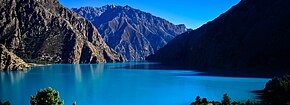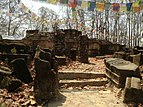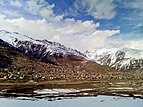Karnali Province
कर्णाली प्रदेश Karṇālī pradēśa | |
|---|---|
From top going clockwise:Phoksundo lake, Sinja Valley, Simikot, Rara lake, ruins of Kakre Bihar in Surkhet and Kanjiroba | |
 Location of Karnali Province | |
Divisions of Karnali Province | |
| Coordinates: 29°16′N 82°11′E / 29.27°N 82.18°E | |
| Country | |
| Formation | 20 September 2015 |
| Named as Karnali | 25 February 2018 |
| Named for | Karnali River |
| Capital | Birendranagar |
| Largest city | Birendranagar |
| Districts | 10 |
| Government | |
| • Type | Province |
| • Body | Government of Karnali Province |
| • Governor | Yagya Raj Joshi |
| • Chief Minister | Yam Lal Kandel |
| • High Court | Surkhet High Court |
| • Provincial Assembly | Unicameral (40 seats) |
| • Parliamentary constituency | Pratinidhi Sabha 12 Rastriya Sabha 8 |
| Area | |
• Total | 27,984 km2 (10,805 sq mi) |
| • Rank | 1st |
| Highest elevation | 7,348 m (24,108 ft) |
| Lowest elevation (Kuine) | 180 m (590 ft) |
| Population (2021) | |
• Total | 1,694,889 |
| • Rank | 7th |
| • Density | 61/km2 (160/sq mi) |
| • Rank | 7th |
| Demonym | Madhya Pashchimeli Nepali |
| Time zone | UTC+5:45 (NST) |
| Geocode | NP-SI |
| ISO 3166 code | NP-P6 |
| Official Language | Nepali |
| Other Official Languages | 1.Jumli 2.Magar |
| HDI | 0.469 (low) |
| HDI rank | 7th |
| Literacy | |
| Sex ratio | 95.78 ♂ /100 ♀ (2011) |
| GDP | US$1.44 billion |
| GDP rank | 7th |
| Website | www.karnali.gov.np |
Karnali Province (Nepali: कर्णाली प्रदेश) is one of the seven federal provinces of Nepal formed by the new constitution, which was adopted on 20 September 2015.[2] The total area of the province is 27,984 square kilometres (10,805 sq mi), making it the largest province in Nepal with 18.97% of the country's area. According to the 2011 Nepal census, the population of the province was 1,570,418, making it the least populous province in Nepal. The province borders the Tibet Autonomous Region of China to the north, Gandaki Province to the east, Sudurpashchim Province to the west, and Lumbini Province to the south.[3] Birendranagar with a population of 154,886 is both the province's capital and largest city.[4]
- ^ https://nepaloutlook.com/karnali-province/#:~:text=The%20highest%20peak%20point%20of,capital%20of%20the%20Karnali%20Province.
- ^ "Nepal Provinces". statoids.com. Archived from the original on 2017-07-18. Retrieved 2016-03-21.
- ^ "Prov 6 named as Karnali, permanent capital in Birendranagar". www.myrepublica.com. 24 February 2018. Archived from the original on 25 February 2018. Retrieved 24 February 2018.
- ^ "Government finalises provinces' governors and temporary headquarters". nepalekhabar.com. 17 January 2018. Archived from the original on 15 November 2020. Retrieved 19 January 2018.







